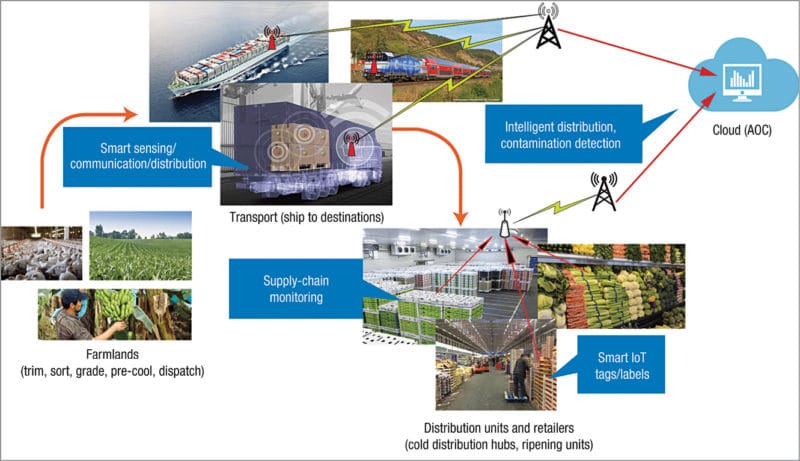Need for IoT is just not restricted to farms; it also plays a vital role in the entire supply chain. IoT systems have sensors that capture data during transit to keep track of parameters that affect food quality in real time.
The Internet of Things (IoT) is playing a great role in the agriculture industry through continuous monitoring of important resources at farms to ensure a good harvest. However, the need for IoT is just not restricted to farms; it also plays a vital role in the entire supply chain, from producers to end consumers.
Companies like Walmart and Amazon procure directly from the farmers to guarantee freshness. But maintaining the freshness of edible items is a challenge. Freshness is measured by shelf life, which starts decreasing from the moment such perishable products are harvested.
With time, as the harvest moves along the supply chain, their quality degrades to such an extent that these products become unsuitable for consumption. The amount of time varies for every item. Quality may decrease at a rapid rate due to environmental factors such as high temperature and humidity. This leads to wastage of food items and loss for retailers. In case such items are still used for consumption, these can potentially cause food-borne diseases.
For this, continuous monitoring is essential. Human-based monitoring is error-prone and tedious. This calls for change at a large scale, which is possible only through IoT. IoT systems have sensors that can act as precise indicators for both businesses and consumers by capturing data during transit to keep track of parameters that affect food quality in real time.
Crest Foods, a restaurant franchisor company, chose refrigeration solutions offered by R9 Technology, a provider of IoT solutions and services for US-based Nestlé Toll House Café by Chip. The main component of the cold-chain monitoring solution is the cellular IoT Gateway, ‘Picogate.’
Picogate is designed around Telit Communications’ LE866A1-NA cellular (4G) module, LE866 series variant for the North American market. The module enables significant reductions in cost, power consumption, and size, which makes it useful for the implementation of LTE technology in IoT, especially in machine-to-machine (M2M) communication.
deviceWISE IoT platform by the company comes with a broad library of pre-built device drivers, connectivity management tools, and application connectors to manage several devices and ensure efficient cellular connectivity. Wired and wireless sensor technologies send data over a sub 1GHz local wireless network to Picogate. deviceWISE IoT platform easily connects to a cloud refrigeration monitoring solution, which has a simple user interface to transmit monitored data.

The advantage is the easy monitoring of connected refrigeration units. In situations that need attention, the concerned person gets a notification instantly. Real-time data enables quick decisions, ultimately saving time and money, besides protecting consumers’ health. Transparency for audits is also ensured as the entire operation of food storage gets recorded.
Farmer’s Fridge is another provider using IoT services from telecommunications company AT&T to deliver fresh food in vans to people on the go. Smart fridges are connected on a single scalable platform where the status is monitored to perform functions like automatic adjusting of temperature and generation of alerts if maintenance is required. Apart from this, connected fridges are also capable of alerting drivers about their delivery route for the next day based on real-time data obtained from monitoring inventory and credit card transactions. Fridges get shut down automatically if there is a continuous power outage for two hours.











